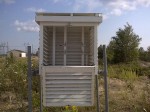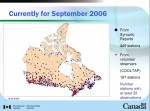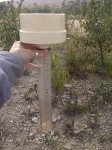COOLTAP
 Environment Canada (EC) has a cooperative/volunteer climate network weather collection project called COOLTAP.(Cooperative Online Temperature and Precipitation Entry System). It is a web-based Data entry system website where daily weather data is entered and used. All that is required is an internet-connected computer to input the data.
Environment Canada (EC) has a cooperative/volunteer climate network weather collection project called COOLTAP.(Cooperative Online Temperature and Precipitation Entry System). It is a web-based Data entry system website where daily weather data is entered and used. All that is required is an internet-connected computer to input the data.
NOAA (USA) uses a similar data collection program called COOP Here is a PDF file on NOAA, COOP and the integration of COOLTAP. This data is used for both weather forecasting/climate prognosis and drought control.

British Columbia lighthouse keepers, as employees in the Pacific and Yukon Region (PYR) of Environment Canada also work in this program as well as performing their many other duties.
Although the program was initially started in the USA c. 2006 as a drought information system, COOLTAP was implemented in Canada in 2004. It was not until 2008 that the lighthouse keepers were invited to join the program.

Because they are on station as part of their job they can supply the data immediately to the forecasters.The forecasters get a summary bulletin of the climate reports each morning and evening and can use them to tweak forecasts and verify warnings, especially for precipitation amounts. (bulletin sample)
This means that the lighthouse keeper’s weather reports are invaluable for weather forecasting as there are no other observers in the area, unlike in a city.

This climate weather is collected twice daily; once at 6 a.m. and again at 6 p.m. It is recorded online at the COOLTAP website (you must be registered to enter), and also on an onsite spreadsheet.
The entry program has a series of Quality Control (QC) parameters so if incorrect data is entered then it will be rejected. (see this PDF file for information on the QC – right click and select Download File )
Below is a list of the data that is recorded (source). More information on the operation of the program is in Environment Canada’s 2006 COOLTAP Manual. (Does anybody know if this is online?)
Daily Climatological Data from COOLTAP (DLY44)
| Elem | Units | Code | Description | ||
|---|---|---|---|---|---|
| 001 | 0.1 deg C | Daily Maximum Temperature | |||
| 002 | 0.1 deg C | Daily Minimum Temperature | |||
| 003 | 0.1 deg C | Daily Mean Temperature | |||
| 010 | 0.1mm | Total Rainfall | |||
| 011 | 0.1cm | Total Snowfall | |||
| 012 | 0.1mm | Total Precipitation | |||
| 013 | cm | Snow on the Ground | |||
| 014-017 Day with… (DLY44) | |||||
| 014 | 1=Yes, 0=No | Thunderstorms | |||
| 015 | 1=Yes, 0=No | Freezing Rain or Drizzle | |||
| 016 | 1=Yes, 0=No | Hail | |||
| 017 | 1=Yes, 0=No | Fog or Ice Fog | |||
It is a good deal for the lighthouse keepers as it keeps them employed, good for Environment Canada forecasters, and good for Canadians.
*****************************
This collected data can be seen online at the end of every month on the Climate Data Online website. Here is an example for Lennard Island lighthouse for the month of November 2011. To find the lighthouse data, you must do a Customized Search and know beforehand the name and spelling of the lighthouse you want, so you can Search by Station Name.
June 24, 2014 – A new weather manual was released called MANCLIM (Manual of Climatological Observations and is available for downloading here in PDF format and viewing here in HTML format.